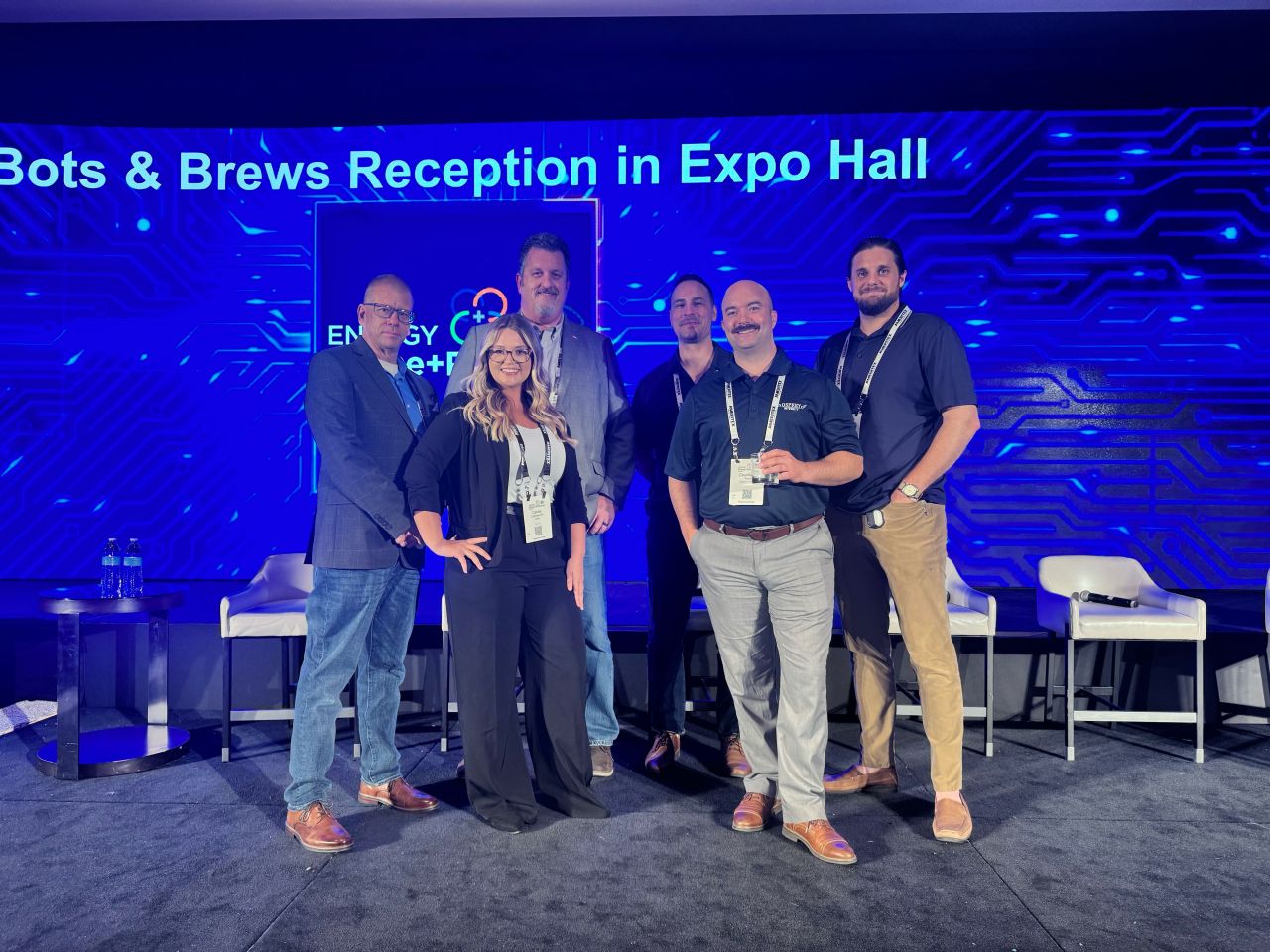Last month, I had the privilege of moderating a panel at the Energy Drones & Robotics Summit called From Hesitation to Integration: Building a Culture of Innovation in Industrial Inspections.
I was joined by an incredible group of experts—leaders from Shell, Dow, Ineos, Occidental Petroleum, and drone service provider Osprey Integrity—who have all worked on the front lines of building drone programs and driving robotics adoption in heavy industries. The conversation was focused on how to change company culture so that people embrace innovation instead of reject it.
This topic comes up all the time when you’re talking about driving drone adoption—but it rarely takes center stage. Instead, we often talk about implementation: how drones are being used, the benefits companies realize by using them, and all the different use cases out there for professional UAVs.
But culture is key. If you want to drive real change at companies, and help them embrace new technologies, culture has to come first. That’s because the single biggest hurdle for getting companies to adopt robotics and AI-powered tools in industrial inspections often isn’t the technology—it’s the people.
In this article, I’ll share the advice we covered in the panel to help you work on changing the culture at your company, and turn it from one of hesitation to one of innovation.
Why Great Tech Fails Without Buy-In
Drone technology is more ready than ever for intensive commercial work, and we have plenty of data to prove it. There are hundreds of examples of drones making inspections safer and faster, saving companies millions in reduced downtime and smaller labor requirements.
So why aren’t more companies rushing to use drones? Put simply, it’s lack of buy-in.
“People take the path of least resistance. The person who does data collection for an inspector may not want to rock the boat, even if you’re telling them, look, we have a drone program you can use. They may just want to do things the old way, and it can be really hard to get them to change.” - Marty Robinson, Senior Robotics Manager at Dow
Challenges with getting people to adopt new technologies, including drones, can come in several different forms.
Some companies may lack the vision at the leadership level to prioritize spending money on drones. And other companies may have leadership that wants to adopt robotics, and even have drone programs, but no one’s actually using the technology—in some cases, employees may not even know these programs exist.
Here are some of the most common barriers to drone adoption in heavy industries:
- Internal clients are unaware of an existing drone program
- Field staff are hesitant to try something new for fear of disrupting workflows
- Engineers have been burned by early failed pilots of innovative technology, now skeptical of all new tech
- Leadership may offer support—but last-minute budget decisions still derails progress
Big Initiatives That Help Drive Change
So how do you overcome these blockers, and move forward with innovation at your company?
One way is by undertaking big, visible initiatives at your company—whether it’s using drones to avoid confined space entries, deploying an underwater ROV to inspect submerged infrastructure, or finding a high-ROI use case like flare stack inspections.
Here are two initiatives shared by our panelists:
Set a Big Goal—Then Talk about It a Lot
Marty Robinson of Dow described launching a robotics program with the goal of avoiding 1,000 confined space entries.
The program exceeded expectations, eliminating over 1,100 in its first year. The data spoke for itself, but the visibility was just as important—they gave 19 internal presentations that year, and the effort snowballed into a global program the following year.
Achieve a Highly Visible ROI Win
Casey Collinsworth of Ineos told a different story—one of ROI.
She built a case to buy a DJI M350 for flare stack inspections. Instead of spending $15,000 per day on contractors, they trained internal inspectors to do the inspection themselves, and paid for the drone in just two days in cost savings. That single use case helped people understand the value of drone inspections across the company.
Both stories highlight a key point: driving culture change often starts with a specific, well-chosen use case. When the results are clear, momentum builds.
5 Tips for Building a Culture of Innovation
In preparing for the panel, I distilled five tips from the panelists on how to drive culture change and adopt robotics successfully.
Here they are, along with a little more context drawn from our conversation.
1. Identify your data needs before choosing tools
Don’t let the shiny object guide your buying decisions. Start with the problem you’re trying to solve and work backward. Ask: What information do I need? Who needs it? In what format?
John McClain from PEMEX emphasized how understanding use cases helped him advocate for drones internally—especially when leadership challenged whether a new tool was a “need” or just a “want.”
2. Start small and prove value early
Quick wins matter. Panelists repeatedly highlighted the importance of choosing low-risk, high-reward applications to get early buy-in.
Marty Robinson of Dow suggested focusing on “low-hanging fruit” where success is more likely—like visual inspections in safe environments. These wins build trust and open the door to broader adoption.
3. Vet vendors like long-term partners
Not all technology is field-ready—even if the vendor’s sales deck says it is.
Casey Collinsworth of Ineos shared a tough lesson from a crawler deployment that over-promised and under-delivered. The tool didn’t work as expected, and this damaged internal trust she’d spent years building.
Lesson: Do pilot programs with newer companies, especially startups, as well as with established companies working on experimental technology that hasn’t been rigorously field-tested.
Ask hard questions, insist on clear reporting, and above all, be transparent with your internal stakeholders about what the tech can (and can’t) do.
4. Treat internal clients as if you are a service provider
Whether you're an in-house or external service provider, you’re still delivering a service. That means it’s important to understand what your clients actually need, and to communicate in their language.
Several panelists shared that internal staff often avoid proposing innovations because they don’t want to challenge their ‘customer’—the person requesting the inspection. If you want to drive adoption, you have to make it easy for people to say yes.
5. Promote awareness with internal marketing
This came up again and again. You can't expect people to use tools they don’t know exist.
Matthew Thrasher from Occidental Petroleum is currently working to expand drone adoption into OxyChem, and he’s had to spend a lot of time just building awareness. Casey Collinsworth of Ineos talked about leveraging internal newsletters, lunch-and-learns, toolbox talks, and success story writeups to get the word out.
If you want culture change, you have to tell the story—over and over and over.
Here are all the internal marketing initiatives you can use to spread the word about your company’s drone program (or other technology initiatives):
- Roadshows
- Lunch & Learns
- Fliers
- Internal newsletters/emails
- Word of mouth/personal conversations
- Let people handle and try the technology firsthand
- Live demos/tech shows
- Invite cross-site participation
- Highlight results with visuals
- Build a strong internal reputation
- Share wins that tie to business impact
Your Next Steps
Culture change requires pressure from both ends.
From leadership, you need support, budget, and the occasional mandate (“No confined space entry without robotics” is one example Marty Robinson from Dow gave). From the field, you need curiosity, champions, and a willingness to try something new.
When both ends meet in the middle, real change happens.
If you want to lead change in your organization, start with the culture. Start small. Tell the story. And keep going, even when it feels like you’re not making progress.
Chances are, you’re having a bigger impact than you know.
















Comments